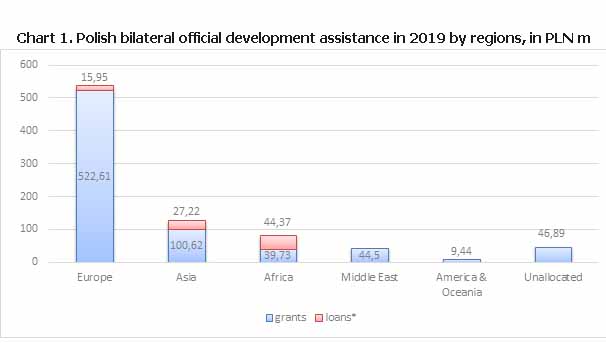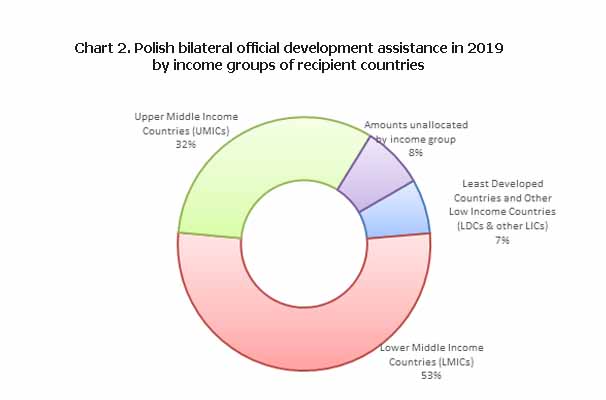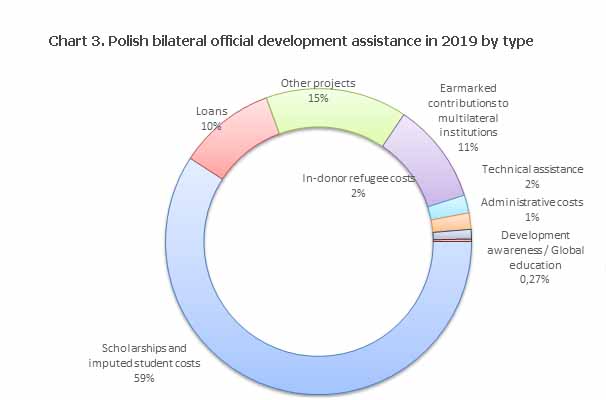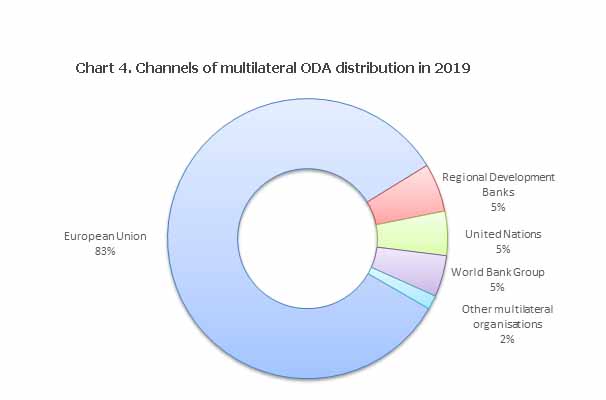Official Development Assistance in 2019
03.08.2020
In 2019, the grant equivalent of Poland’s Official Development Assistance (ODA) was nearly PLN 3 billion.

Under multilateral cooperation, or contributions to general budgets of international development organisations, PLN 2.124 billion was spent, which accounted for 71% of all funds. Poland allocated over PLN 851 million (29%) for bilateral assistance. The ratio of ODA to gross national income did not change compared with the previous year and amounts to 0.14 %.
Geographic and thematic priorities
In 2019, development cooperation was based on the Multiannual Development Cooperation Programme for 2016-2020. In line with the Programme, Polish development cooperation is carried out as part of geographic and thematic priorities.
Geographical areas were divided into two groups. The first covers the four countries of the Eastern Partnership: Belarus, Georgia, Moldova, and Ukraine, where Polish aid focuses on supporting good governance, human capital, entrepreneurship and the private sector, as well as agriculture and rural development.
The second group covers selected countries in Africa, Asia, and the Middle East. It includes eight countries: Ethiopia, Kenya, Lebanon, Myanmar, Palestine, Senegal, Tanzania, and Uganda. Most of them are characterized by a high level of poverty. In these countries, assistance is directed at human capital, environmental protection, entrepreneurship and the private sector, and agriculture and rural development.
Apart from the above-mentioned priority countries, Poland also supports other states countries which are included in the list of developing countries in line with OECD DAC guidelines (DAC List of ODA Recipients).
Bilateral ODA
In 2019, key recipients of Polish bilateral assistance were: Ukraine, Belarus, Turkey, Tanzania, India, Mongolia, China, Kenya, Iraq, Georgia, Moldova, and Lebanon (details below).
Table 1. List of largest recipients of Polish ODA in 2019
|
Item |
Recipient of Polish ODA |
PLN m |
|
1. |
Ukraine |
303.55 |
|
2. |
Belarus |
150.29 |
|
3. |
Turkey* |
51.61 |
|
4. |
Tanzania |
39.05 |
|
5. |
India |
29.05 |
|
6. |
Mongolia |
27.23 |
|
7. |
China |
20.52 |
|
8. |
Kenya |
16.00 |
|
9. |
Iraq |
13.26 |
|
10. |
Georgia |
11.04 |
|
11. |
Moldova |
10.62 |
|
12. |
Lebanon |
8.55 |
*This item includes a contribution to the EU Facility for Refugees in Turkey, of PLN 39.92 million
In 2019 (as in the preceding year), Poland’s aid targeted European countries, followed by those from Asia, Africa, and the Middle East. It largely comprised tied aid loans chiefly for countries in Africa and Asia.
* the grant equivalent of loans disbursed in 2019
As regards the breakdown of bilateral cooperation by income groups of recipient countries, over half of Poland’s bilateral ODA goes to Lower Middle Income Countries (53%), followed by Upper Middle Income Countries (32%), with Least Developed Countries and Other Low Income Countries representing the smallest share (7%).
In 2019, the largest share of bilateral cooperation was earmarked for scholarships and the costs of education, at nearly PLN 504 million; project activities (excluding loan agreements, at PLN 87.5 million of the grant equivalent) exceeded PLN 127 million. Earmarked contributions through international institutions and assistance funds totalled PLN 91 million. Poland’s costs of hosting refugees amounted to over PLN 16 million.
In 2019, Poland provided PLN 71.4 million for bilateral humanitarian aid, most of which was used for Turkey, Iraq, Lebanon, Syria, and Ukraine.
Multilateral ODA
According to OECD DAC guidelines, multilateral development assistance is understood as contributions to general budgets of international organisations entered in the list approved by OECD DAC members
(i.e. Annex 2. List of ODA-eligible international organisations).
In 2019, the largest part of Polish multilateral development assistance traditionally contributed to European Union funds allocated to external development assistance. In 2019, Poland’s participation in these funds reached PLN 1.761 billion. It was composed of part of the EU budget contribution allocated to development goals (PLN 1.363 billion1) and a contribution (PLN 398 million[2]) to the European Development Fund (EDF), which is the EU’s key non-budgetary instrument to finance cooperation with African, Caribbean and Pacific (ACP) countries and Overseas Countries and Territories (OCTs).
Poland earmarked almost PLN 119 million for general budgets of entities working within the United Nations System. There were also large contributions to regional development banks and World Bank Group institutions (PLN 109 million and 101 million, respectively).
Chart 4. Channels of multilateral ODA distribution in 2019
[1] Poland makes one contribution to the EU budget without differentiating into specific programmes, funds, or instruments. Poland’s participation in the European Union’s official development assistance is calculated in the following way: knowing the size of the EU budget and the value of Polish contribution it is possible to express the latter as a percentage of the former. Assuming that Poland’s participation in the EU’s official development assistance is the same as its participation in all of the EU budget, it can be calculated based on data from the EU budget execution. Estimated data from budget execution are updated according to the European Commission’s successive reports, so they can be subject to substantive changes.
2] The value of the Member States’ contributions to the European Development Fund is defined each time by the European Commission based on its estimate of financial needs connected with actions envisaged under a given EDF. Unused funding from a given EDF is not reimbursed to the payers. Instead, it is transferred to the next EDF.



